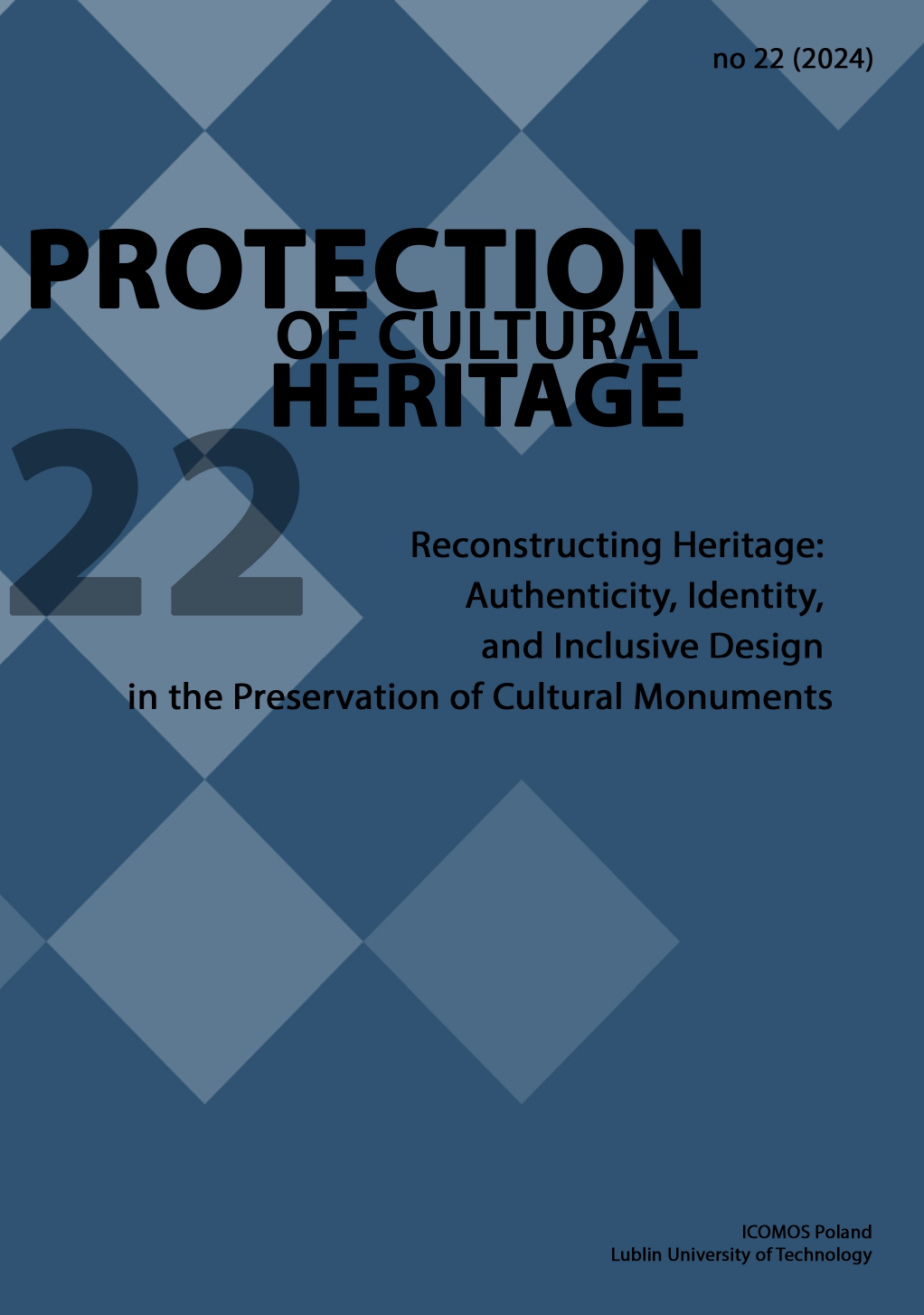Stocktaking methods of facilities in a state of ruin
Katarzyna Drobek
Faculty of Civil Engineering and Architecture, Lublin University of Technology (Poland)
Bartosz Szostak
Faculty of Civil Engineering and Architecture, Lublin University of Technology (Poland)
https://orcid.org/0000-0003-0502-6157
Wojciech Królikowski
Faculty of Civil Engineering and Architecture, Lublin University of Technology (Poland)
Abstract
The measured building survey is the basic form of presenting and protecting the object of the historic ruin. It also allows us to control the behavior and the progress of the degradation of the object. The ruined objects are very specific because they usually contain not all elements of an traditional building object. This means that the methods and methods of inventory taking, as in the case of traditional objects, may not be sufficient. Elements of objects in ruins often have complicated and diverse geometry, difficult and not completely safe access to all elements. The publication presents methods that can be helpful in the inventory of such objects. Each method describes the necessary instruments, the method of taking measurements, accuracy, advantages and limitations. The paper also presents examples of application for selected methods.
Keywords:
photogrammetry, 3D scanning, photography, heritage, ruins, inventory, measured building surveyReferences
Bar E., Fałdrowicz J., Dokumentowanie zabytków architektury metodami fotogrametrycznymi i skaningu laserowego, Acta Scientifica Academiae Ostroviensis, nr 34, 2010.
Google Scholar
Brusaporci S., The Representation of Architectural Heritage in the Digital Age, Encyclopedia of Information Science and Technology, Information Resources Management, USA, 2005.
Google Scholar
Brykowska M., Metody pomiarów i badań zabytków architektury, Oficyna Wydawnicza Politechniki Warszawskiej, 2003.
Google Scholar
Centofanti M, Brusaporci S., Interpretative 3D digital models in architectural surveying of historical buildings, Computational modelling of objects represented in images. CRC Press, Londyn, 2012.
DOI: https://doi.org/10.1201/b12753-80
Google Scholar
Gołembnik A., Rola nowych technik dokumentacyjno-pomiarowych w interdyscyplinarnych działaniach badawczo-konserwatorskich, Wiadomości Konserwatorskie, nr 40/2014.
Google Scholar
Gołka J., Haliński J., Fotogrametria cyfrowa w architekturze – nowe możliwości inwentaryzacji i archiwizacji obiektów, Archiwum Fotogrametrii, Kartografii i Teledetekcji, t. 10, 2000.
Google Scholar
Jachimski J., Fotogrametryczna inwentaryzacja obiektów zabytkowych, Archiwum Fotogrametrii, Kartografii i Teledetekcji, t. 7, 1997.
Google Scholar
Klimkowska H., Wróbel. A., Uwagi o wykorzystaniu tachimetrów bezlustrowych w inwenaryzacji architektonicznej, Archiwum Fotogrametrii, Kartografii i Teledetekcji, t. 16, 2016.
Google Scholar
Kwoczyńska B., Opracowanie obiektów architektonicznych z wykorzystaniem metod stosowanych w fotogrametrii cyfrowej, Infrastruktura i ekologia terenów wiejskich, nr 3/2010, Polska Akademia Nauk, Odział w Krakowie.
Google Scholar
Parat M., Schaaf Urlich, Inwentaryzacja pomiarowo-rysunkowa zabytków architektury drewnianej w procesie konserwatorskim – problemy i propozycja standaryzacji, Budownictwo i Architektura, t. 14(4), 2015.
Google Scholar
Prarat M., Wykorzystanie tachimetrii i fotogrametrii w dokumentacji zabytków architektury na przykładzie inwentaryzacji pomiarowo-rysunkowej wybranych kamienic toruńskich, Acta Universitatis Nicolai Copernici, nr 46, 2015.
DOI: https://doi.org/10.12775/AUNC_ZiK.2015.020
Google Scholar
Szmygin B., Wprowadzenie, Trwała ruina II. Problemy utrzymania i adaptacji. Ochrona, konserwacja i adaptacja zabytkowych murów, Lublin-Warszawa, 2010.
Google Scholar
Tajchman J., Standardy w zakresie projektowania, realizacji i nadzorów prac konserwatorskich dotyczących zabytków architektury i budownictwa, Narodowy Instytut Dziedzictwa, Warszawa, 2014.
Google Scholar
Trizio I., GIS-technologies and Cultural Heritage: stocktaking, documentation and management. In Rethinking Cultural Heritage, Experiences from Europe and Asia, Dresden: Technische Universität Drezno, 2007.
Google Scholar
Uścinowicz J., Standards of conservation documentation of wooden architecture facilities as a basis for monitoring and management, Documentation and the monitoring in managing timber objects in Krzysztof Kluk Museum of Agriculture in Ciechanowiec and the Ryfylke Museum, Krzysztof Kluk Museum of Agriculture in Ciechanowiec, 2015.
Google Scholar
Wytyczne Techniczne G-3.4, Inwentaryzacja zespołów urbanistycznych, zespołów zieleni i obiektów architektury, GUGiK, Warszawa, 1981.
Google Scholar
PN-70/B-02365 – Powierzchnie budynków – Podział, określenia i zasady obmiaru.
Google Scholar
PN-ISO9836:1997 – Właściwości użytkowe w budownictwie – Określenie i obliczanie wskaźników powierzchniowych i kubaturowych.
Google Scholar
http://geo-metric.com/fotogrametria-cyfrowa, (dostęp: 24.07.2018).
Google Scholar
http://www.wrogeo.pl/pl/fotogrametria.html, (dostęp: 24.07.2018).
Google Scholar
Authors
Katarzyna DrobekFaculty of Civil Engineering and Architecture, Lublin University of Technology Poland
mgr inż. arch., specjalista do spraw nowoczesnych technik i technologii w ochronie historycznych ruin. Podejmuje zagadnienia związane z problemami architektonicznymi w obiektach zabytkowych. Najczęściej poruszana tematyka to adaptacja oraz rewitalizacja. Zajmuje się projektowaniem obiektów nowych oraz projektowaniem w obiektach już istniejących, w tym również zabytkowych. Autorka i współautorka licznych projektów architektonicznych oraz kilku publikacji naukowych.
Authors
Bartosz SzostakFaculty of Civil Engineering and Architecture, Lublin University of Technology Poland
https://orcid.org/0000-0003-0502-6157
mgr inż., absolwent Wydziału Budownictwa i Architektury Politechniki Lubelskiej, asystent w Katedrze Konserwacji Zabytków Politechniki Lubelskiej. Specjalizuje się w zagadnieniach związanych z dokumentowaniem i analizą konstrukcji oraz oceną stanu technicznego obiektów. Posiada uprawnienia budowlane do projektowania i kierowania robotami budowlanymi. Autor i współautor ponad 15 publikacji naukowych oraz około 100 opracowań technicznych (projekty, opinie, ekspertyzy).
Authors
Wojciech KrólikowskiFaculty of Civil Engineering and Architecture, Lublin University of Technology Poland
mgr inż., absolwent Wydziału Budownictwa i Architektury Politechniki Lubelskiej, Specjalista do spraw badań i analiz w zakresie konserwacji historycznych ruin. Posiada uprawnienia budowlane do kierowania robotami budowlanymi. Współautor publikacji naukowych oraz licznych opracowań technicznych.
Statistics
Abstract views: 252PDF downloads: 480








